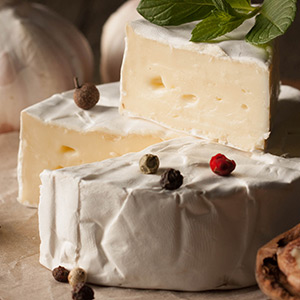- Cook cream cheese, it's a breeze
- Quebec Cheeses to Discover
- Selecting and Storing Cheeses
- Time For Quebec Cheese
- Classification of Cheeses
- Artisanal Cheeses
- Au Gratin, Stuffing, Dessert… How to Choose the Right Cheese
- Learn How To Serve Cheese
- Make Your Cheese Tasting a Success
- More Cheese Please!
- Cooking with Cheese
- Cheese on the menu
- Apple Cheese Pairings
Cheese on the menu

There are two ways to appreciate cheese: as an ingredient in a recipe or on its own, as a food or meal. In fact, there are many regional dishes like croque-monsieur, fondue and raclette that are known around the world.
A cheese plate is usually served just before dessert and is considered a course in itself. This is where flavours must be considered.
Light meals of poultry or fish
A light or medium cheese should be selected.
Spicier meal, red meat
A stronger-flavoured cheese can be served.
As far as quantity, remember not to serve too much, just a taste; it's not a wine and cheese party, it's a course!
When pairing cheese with wine or bread you must respect certain food-pairing principles like balance, contrast, texture, taste and aroma. For instance, a mild white bread is best with a subtle, more delicately-flavoured cheese. Robust cheeses pair well with more flavourful, multigrain bread. Marriages of wines and cheeses are successful when they balance each other out as well as complement one another. As an example, a salty cheese will pair well with a more acid wine to offer some similarity. On the other hand, a very sharp cheese will bring a good contrast to a sweet wine that is high in alcohol.

Should you serve cheese with or without the rind?
In the case of soft cheeses and semi-firm cheeses, with the exception of waxed rinds, the rind is edible and part of the cheese.
In the case of firm and hard cheeses, the rind is generally dry and hard and should be removed before serving.
Some cheeses have an orange curd that is produced by adding a plant called annatto seeds to the milk during processing. This natural colouring is rich in carotene, the natural pigment found in carrots. The curd can sometimes also be coloured naturally because of the type of milk used: cow, sheep, goat or a mix of cow and goat milk.
The colouring used for collagen-based skins or rinds in some cheese like Forêt Noire and Saint-Paulin is an artificial food coloring that is edible and does not constitute a health risk.
Cheese Recipes

Recipe
Three Cheeses Macaroni
















